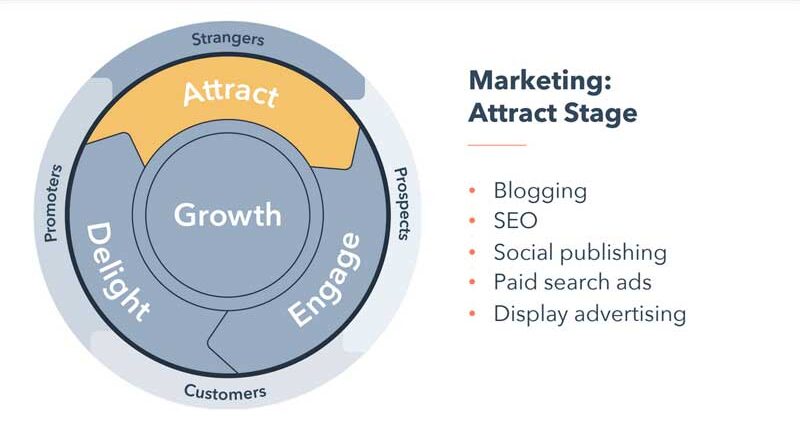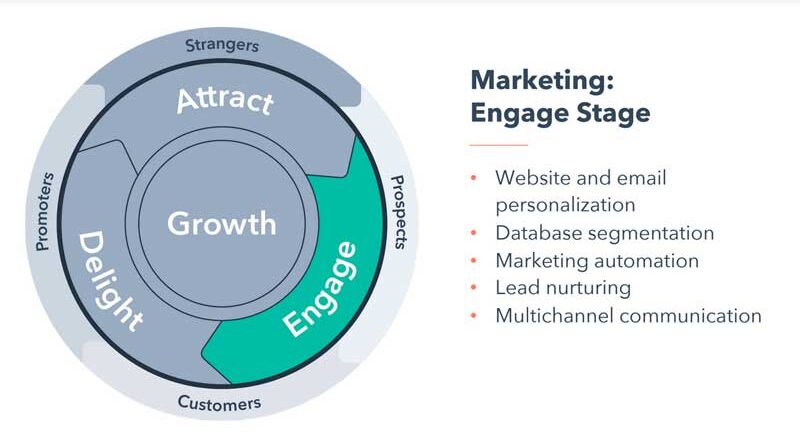Why Should You Invest in Inbound Marketing?
In all great stories, the concept of the hero's journey is simple. The beloved hero goes on a quest, faces untold difficulty, but rises victorious and returns home transformed.

They'll have help along the way, of course. Often taking the form of a sage or wizard, there's usually someone who aids the hero on their adventure, providing guidance and advice.
This guardian helps the hero grow to their fullest potential and achieve what they set out to do.

When it comes to marketing, the role of the sage advisor falls to you. Every prospect and customer is on a quest to accomplish a set of goals.
They may not know where their journey with you will lead them quite yet, but as a marketer, it’s your job to act as a guide.

This means being ready for any of your visitors’ questions or concerns when they need answers the most. Why? In short, your help, education, and attention builds trust between you and your prospect or customer.
The question then becomes, how do you scalable-y interact with the multitude of buyers pursuing your site and marketing channels?
How do you go beyond answering questions to empower and inspire so many potential buyers? The answer is Inbound marketing.
What is inbound marketing?
Inbound marketing is a strategy that attracts and retains customers by creating valuable content and tailored experiences.
Inbound marketing forms connections customers are looking for and solves problems they already have.
While outbound marketing interrupts your audience with content they don't always want, inbound marketing seamlessly integrates into a buyer's decision-making landscape.
Effective inbound marketing relies on the successful implementation of the inbound methodology across all your marketing strategies.
The inbound methodology is a method for growing an organization by building lasting relationships with people and helping them reach their goals. This is carried out in three stages: attract, engage, and delight.
Marketing applications of the inbound methodology
Let’s examine and review the marketing applications for each stage: attract, engage, and delight.
Attract stage
In the attract stage, you attract visitors with useful content and eliminate barriers as they learn about your company. The key is to earn people's attention, not force it.

When applied to marketing, this means using strategies like blogging, SEO, social media marketing, paid search ads, and display advertising.
Together, these approaches will help you reach your target buyers on the channels they’re using to look for solutions to their problems, ways to achieve their goals, or browse new products and services of interest.

Pro-tip: Focus on the attract stage if your goal is to generate more traffic and leads.
Engage stage
In the engage stage, you make it easy for customers to shop and buy from you by enabling buyers to interact with you on their preferred timelines and channels. Here, you focus on opening relationships, not just closing deals.

When applied to marketing, this means using website and email personalization, database segmentation, marketing automation, lead nurturing, and multichannel communication (such as chat and messaging).
These tools help you build trust with your leads and start to deliver awesome content at every stage in their decision-making process.

Pro-tip: Focus on the engage stage if you are looking to convert more leads and prospects or trying to lower the cost to acquire new customers.
Delight stage
Finally, in the delight stage, you help, support, and empower customers to reach their goals. Here, you focus on creating buzz around your brand.

When applied to marketing, this means using social mentions, reviews, word-of-mouth marketing, a customer loyalty program, or user-generated content.

Oftentimes, this requires you to shift your resources so they're more effectively distributed throughout the entire customer experience.
The payoff comes in the form of more loyal customers and new referral traffic to your site.
This brings us to our last pro tip:
Focus on the delight stage if you’re looking to improve your customer retention, customer lifetime value, and referrals.
Overall, these strategies help you remain present and in tune with your leads and customers. But effective implementation of any of these strategies at any stage requires a few processes to be in place.
They will act as guardrails and ensure no matter the exact strategy or tactic you use, your buyers are at the center of everything you do.
To start, you need to research and fully understand who you’re trying to reach.
After all, you don’t want just any traffic to your site. You want the right traffic.
And the right traffic is the visitors who are most likely to become leads, and, ultimately, happy customers. These visitors fit your buyer personas.
Buyer Personas
Buyer personas are created through research, analysis, and taking a close look at who’s already buying from you. They can help you get into the mindset of your potential buyers and create the right content.
Buyer personas help you identify groups in your customer base that share similar demographics, psychographics, and behaviors.
They reveal what these groups of visitors want to see, when to deliver it, and how to better service folks throughout their lifecycle with your business.
This information about who your leads are and their preferences will also help inform how you'll go about personalizing your content to fit their needs — which brings us to the buyer’s journey.
Throughout the buyer's journey, your visitors will overcome their challenges and accomplish their goals differently.
You’ll need to understand what they’re thinking and — potentially more importantly — feeling, as they progress toward making a purchase.
That way you can match them step-for-step; from the awareness that a problem exists, to consideration of the potential solutions, until they reach a decision.
Knowing who your leads and customers are, the type of content they want to interact with, and when they need content is a great first step.
Next, you need to know about their preferred platforms and methods of communication. That is, where would they like to engage online?
Think critically about your publishing and distribution channels. Consider how you’re leveraging ads, engagement, and business pages on platforms like Facebook, TikTok, Instagram, or Twitter.
Are your buyers turning to search engines like Google for research? Consider your content strategy. Where are you currently ranking with content like pillar pages, blog posts, or video content?
This may seem like a lot of information to unpack and understand upfront. But, doing this research and getting these answers will inform how you reach and engage with users. This level of personalization pays off.
Personalization pays off
According to a study conducted by Epsilon, 80% of consumers are more likely to make a purchase when brands offer personalized experiences.

Furthermore, Adobe found that 67% of consumers think it’s important for brands to automatically adjust content based on the current context.
That same study cautioned that 42% of consumers will "get annoyed" if brands don't adjust their content to their needs. Which, in your day-to-day, is why you need segmentation and automation.

These strategies help you ensure your outreach and lead nurturing are both efficient and effective
Unique user experiences
Now, customers expect unique experiences. This includes tailored recommendations, dynamic content, and exclusive offers.
These are usually configured based on a visitor's behavior on your website, their demographics, and their interests.
Audience segmentation helps group your most important buyers based on behavioral and demographic data.
Using that data, you can determine which of those audiences are most valuable and most receptive to certain kinds of messages, and therefore, which audiences you should focus on creating content for.
Similarly, effective marketing automation considers the evolving needs of your leads, and the behaviors and interactions they have with you across all of your marketing channels — not just email.
Using behavioral inputs from multiple channels, such as likes on your social media posts, views to your pricing page, or engagements with particular pieces of content gives you the context you need to fully understand a lead’s challenges.
Marketing attribution reports
But how do you know all this effort is paying off? You need to know what’s working and what’s not for your marketing team. That takes a special type of reporting: marketing attribution reports.
Marketing attribution reports pull together all the relevant interactions from your buyers' journey using pre-built models that can definitively answer which channels and content are helping you meet your marketing goals.
They help you and your team get the credit you deserve. That's important because, in the past, it's been really difficult for marketing teams to prove their contribution to their company's bottom line.
With attribution reports, you can show just how much influence your content had, which can help you advocate for more headcount and budget.

As you can see, before diving into all the strategies that can power your inbound marketing flywheel, you need to start with a strong foundation.
By building your inbound marketing strategy with these pieces in place, you can make data-driven decisions, grow sustainably, and ensure your customer is at the heart of everything you do.

And, while the customer may be the hero, you have the opportunity to help educate and inspire them along the way.
Inbound marketing is about making your customers more successful, building relationships by doing the right thing, and focusing on the long-term even when it's not the easiest path.
By focusing on your customers, your business will grow better.
Invest in Inbound Marketing
Just as you should build your inbound marketing strategies around your buyer personas, you should build your marketing toolkit around your customer data.
Any company that wants to maintain a relationship with its customers can benefit from using a CRM — customer relationship management tool.
As its name suggests, CRM software is a system for managing relationships with your customers.
For most businesses, their most valuable and important asset is their customers.
And at most companies, the details about those customers — who they are and how they’ve interacted with your organization — are spread out in many different places.
Your prospects and customers will notice the effects of a disjointed team. From their perspective, they have a relationship with one company, not a collection of different people and departments.
Everyone on your team needs context about every customer’s needs, wants, and current state, so they can pick up the conversation where it left off.
A CRM provides one central place to organize all the details of your leads and customers. It makes it easy for everyone on your team to gain insight into the state of your business and the status of every customer relationship.
But how do you manage all the moving pieces of a marketing campaign or project?
There are many project management tools you could or may want to use.
But between a CRM and a comprehensive MarTech stack that includes automation, reporting, collaboration, and project management features, you’ll have the inbound marketing toolkit you need to attract, engage, and delight your customers at scale.







